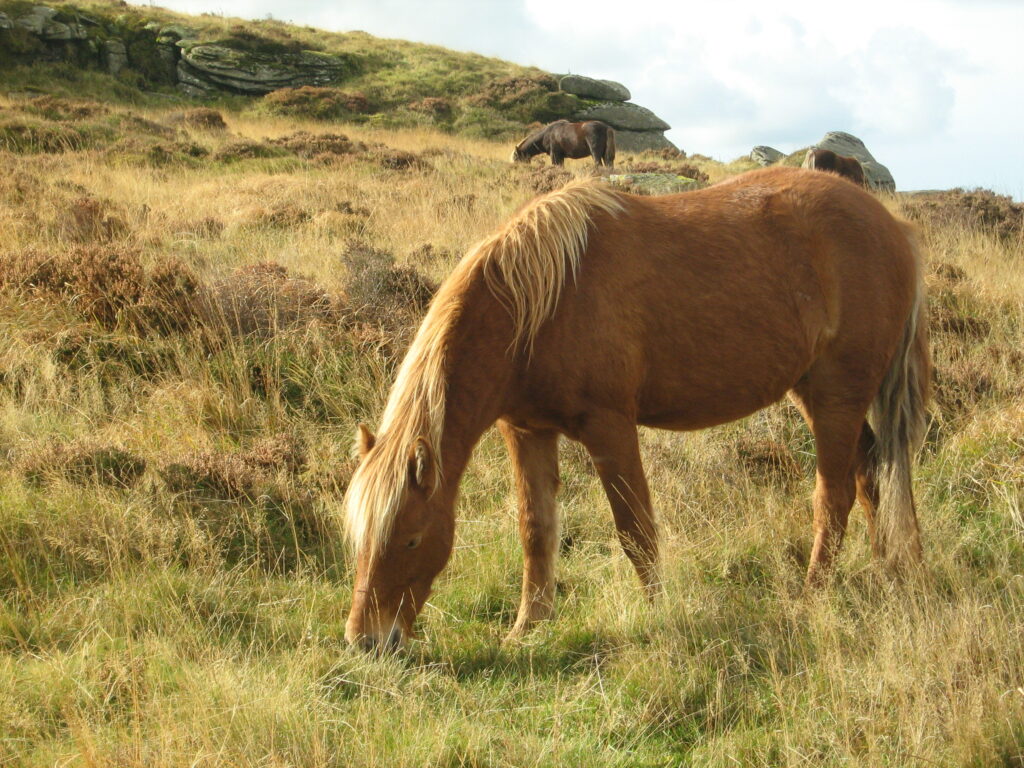Horses in the Rewilding landscape

In the last few weeks I have blogged on various rewilding subjects
( http://www.hillwise.co.uk/2021/01/blanket-bog-restoration-a-real-emergency/ and http://www.hillwise.co.uk/2021/01/rewilding-a-religion-for-our-times/ amongst others) and in those blogs and the responses to them, there seemed to be a broad consensus towards a British landscape where we have blanket bog on uplands where it is currently, or has been, and woodland on the marginal lands, often steep, rocky, hard to farm,(ideally regenerated, but planted where necessary). This leaves most food production on much of the lowlands. This is a broad brush description of an idealised countryside, but you get the idea.
One of the tensions of “Rewilding” is between the need to restore biodiversity to the landscape and the need to grow or produce food. Often we are told that we cannot waste good food producing land on trees. Only last week I saw a press release by an estate announcing a programme of tree planting, and at my last glance it had received approximately 650 negative comments about destroying good farmland. Clearly there is a lot of sympathy out there in the real world for this viewpoint, but if we are to take it seriously we need to consider horses.
Over the last 50 years living in the South West of England, I have been noticing a steady increase in land given over to horses. Not any old land but good productive farmland. This is not the regular rotation of land use chopping between arable, and grazing sheep or cows. With horse grazing you quickly see the construction of stable blocks, an application for ancillary accommodation, and in some cases eventual establishment of new permanent housing. Of course in the past we had far more horses in the landscape than we do now. Horses powered our farming and transport. However we also had a much smaller population, so less land was needed for human food production and more land could be spared for horse grazing and fodder. Many of those horses never saw a field, being kept in stables in cities and fed with fodder produced in the countryside. This would have been grown long and cropped more efficiently than occurs when horses graze fields, as they trample as much as much as they eat. As in so much of life, it’s all about balance.
At this point some of you will be starting to think I’m anti-horse, but that is far from the case. I love to see horses in the landscape. They aren’t native, but they have been here a long time. They have shaped our landscape and have a place in it’s future. In my area heavy horses are still used to remove timber in sensitive woodland. Horses are used for conservation grazing, as they will trample and graze areas that cows or sheep will avoid, in particular they keep back bracken. Another feature of horses is they have a very different stomach to ruminants like cows, and this means that they are much better at seed dispersal, as any allotment holder who’s used their manure will tell you! Horses don’t crop grass as short as sheep either.
So the paradox is that currently our uplands could stand more horses and ponies, where they are being reduced to minimal levels, due to there being no market for hill ponies to sustain their keeping, (in many cases you can buy a hill pony for less money than the cost of it’s annual inoculations), whereas there seem to be increasing numbers of horses grazing the rich productive lowland pastures that will be needed if we are to rewild the marginal lands in the middle. These horses are generally for recreation and sport, either amateur or commercial, and each horse seems to need quite a lot of field. Its not a conversation that’s getting much of an airing yet, but I think it’s one we will have to have, if we are to regenerate as much woodland as we need to. A case of horses for courses?


This is interesting as horses are actually browsers and do best on a mix of grass and tree/shrub browse. They do not need the pure grass fields that many feel they need. In fact, more trees and hedgerows around and in horse fields is beneficial to them as windbreaks too. I agree that there are a lot of potentially food producing fields that are horse grazed, but the horses are where the people who like them want them. Where I live in Surrey, the only thing that replaces horse fields is houses! It is mostly grade 3 agricultural land, so considered by many to be not overly productive under commercial farming. So perhaps educating the horse owners into lining their fields with hedgerow and planting trees within the fields to create more woodland within the horse fields.
Thanks for your feedback, glad you enjoyed it. In my wider area, fields that were arable growing oil seed rape and food crops have now gone to horses. The change has been quite astonishing in the last 20 years.